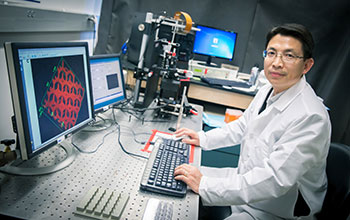Multimedia Gallery
Bioprinting a 3-D liver-like device to detoxify the blood
Nanoengineering professor Shaochen Chen led a team of nanoengineers at the University of California, San Diego, in developing a 3-D-printed device inspired by the liver to remove dangerous toxins from the blood. The device, which is designed to be used outside the body--much like dialysis, uses nanoparticles to trap pore-forming toxins that can damage cellular membranes and are a key factor in illnesses that result from animal bites and stings, and bacterial infections.
While nanoparticles have been shown to be effective at neutralizing pore-forming toxins in the blood, if those nanoparticles cannot be effectively digested they can accumulate in the liver, creating a risk of secondary poisoning, particularly in patients already at risk of liver failure. So Chen and his team created a 3-D-printed hydrogel matrix to house nanoparticles, thereby forming a device that mimics the function of the liver by sensing, attracting and capturing toxins routed from the blood. The device, which is in the proof-of-concept stage, mimics the structure of the liver but has a larger surface area designed to efficiently attract and trap toxins within the device. In an in vitro study, the device completely neutralized pore-forming toxins.
The research was supported in part by a grant from the National Science Foundation (CMMI 11-20795).
To learn more, see the UC-San Diego news story Bioprinting a 3-D liver-like device to detoxify the blood. (Date of Image: May 2014)
Credit: University of California, San Diego, Jacobs School of Engineering
See other images like this on your iPhone or iPad download NSF Science Zone on the Apple App Store.
Images and other media in the National Science Foundation Multimedia Gallery are available for use in print and electronic material by NSF employees, members of the media, university staff, teachers and the general public. All media in the gallery are intended for personal, educational and nonprofit/non-commercial use only.
Images credited to the National Science Foundation, a federal agency, are in the public domain. The images were created by employees of the United States Government as part of their official duties or prepared by contractors as "works for hire" for NSF. You may freely use NSF-credited images and, at your discretion, credit NSF with a "Courtesy: National Science Foundation" notation.
Additional information about general usage can be found in Conditions.
Also Available:
Download the high-resolution JPG version of the image. (8.7 MB)
Use your mouse to right-click (Mac users may need to Ctrl-click) the link above and choose the option that will save the file or target to your computer.



